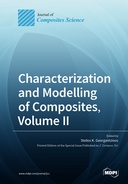Explore

Characterization and Modelling of Composites, Volume II
0 Ungluers have
Faved this Work
Login to Fave
Composites have been increasingly used in various structural components in the aerospace, marine, automotive, and wind energy sectors. Composites’ material characterization is a vital part of the product development and production process. Physical, mechanical, and chemical characterization helps developers to further their understanding of products and materials, thus ensuring quality control. Achieving an in-depth understanding and consequent improvement of the general performance of these materials, however, still requires complex material modeling and simulation tools, which are often multiscale and encompass multiphysics. This Special Issue is aimed at soliciting promising, recent developments in composite modeling, simulation, and characterization, in both design and manufacturing areas, including experimental as well as industrial-scale case studies. All submitted manuscripts will undergo a rigorous review and will only be considered for publication if they meet journal standards.
This book is included in DOAB.
Why read this book? Have your say.
You must be logged in to comment.
Rights Information
Are you the author or publisher of this work? If so, you can claim it as yours by registering as an Unglue.it rights holder.Downloads
This work has been downloaded 94 times via unglue.it ebook links.
- 94 - pdf (CC BY) at Unglue.it.
Keywords
- 3D filament winding
- 3D printing
- 3D woven fabrics
- 4D printing
- 6D printing
- acrylonitrile butadiene styrene (ABS) filament
- additive manufacturing
- Additive Manufacturing (AM)
- advanced composites
- analytical model
- automated fiber placement
- Bark
- bimodal microstructure
- biomedical implants
- Bladder
- boron nitride nanotubes
- buckling
- Cannabis
- carbon nanotubes
- Characterization
- Chemical engineering
- commingled yarn
- complexity
- composite
- composite fatigue
- composite material
- Composite materials
- composite pile
- composite structures
- composites
- compressive behavior
- conveyor belts
- cost model
- crack detection
- crashworthiness
- Crystal plasticity
- damage
- damage mechanics
- DAMASK
- Defect Layer Method
- drive shaft
- drop test
- effective property
- elastic property
- electrolyte
- Experiments
- explicit analysis
- externally bonded carbon fibre-reinforced polymer (EB-CFRP) composites
- failure envelope
- fatigue damage model
- FDM
- FEA
- FEM
- fiber orientation
- fiber skeleton
- fiber-reinforced polymer composite
- fiber-reinforced polymers
- finite element analysis
- Finite element method
- finite element modeling
- finite-element method
- fire-hazard
- FLM
- Folgar Tucker model
- fracture toughness
- fuel tank
- Fundamental frequency
- fused deposition modeling
- fused deposition modeling (FDM)
- fused filament fabrication (FFF)
- fused layer modeling
- generalized multiscale finite element method
- genetic algorithm
- genetic algorithm optimization
- geometry modeling
- glass/epoxy composite
- glass/polyester composite joints
- Hemp
- high pressure resin transfer molding
- homogenization methods
- hyperelastic
- image segmentation
- important genes
- Industrial Chemistry
- Industrial chemistry & manufacturing technologies
- injection molding simulation
- insulation composites
- interphase/interface
- Jacquard
- LAGP
- laminated composites
- Learning
- lightweight structures
- lithium
- loading point ratio
- local deformation behavior
- local ductile damage
- LS-DYNA
- material modeling
- material models
- mathematical modeling
- Mechanical properties
- Microstructure
- microstructure-based
- microstructure-free
- modeling
- moisture diffusion
- mold filling
- multicomponent suspensions
- multiscale
- multiscale characterization
- nanocomposites
- natural frequency
- non-equilibrium energy molding
- nondestructive testing (NDT)
- Numerical Simulation
- off-axis cracks
- OpenFOAM
- particulate composite
- pipe
- polylactic acid (PLA) filament
- polymer materials
- polyurethane foam
- Porous media
- porous scaffold
- preform
- process simulation
- progressive crushing
- quadratic failure function
- reinforced concrete beams
- representative volume element
- representative volume elements
- ring stiffness infrastructure industries
- rule of mixtures
- sandwich structures
- SFRP
- shear strengthening
- short fiber-reinforced thermoplastic
- short fibre reinforced plastics
- short-fiber reinforced thermoplastic components
- SHPB technique
- simulation
- size effect
- Smart materials
- smoothed particle hydrodynamics
- SPH
- spherical indentation
- spheroidized steel
- steel cables
- steel-cable-reinforced rubber
- Stefan problem
- strain proportionality factor
- strength
- strength ratio
- stress–strain curve
- Structural dynamics
- structural simulation
- submodelling
- Technology, engineering, agriculture
- Technology: general issues
- thermal conduction
- thermal decomposition
- Thermal properties
- Ti6242
- tiltrotor
- Titanium
- transverse shear strengths
- transversely isotropic materials
- Tsai–Wu criterion
- variable angle tow
- variable stiffness composite
- Weavebird
- X-ray computed microtomography
Links
DOI: 10.3390/books978-3-0365-5508-9Editions

